ServiceNow Connector Example¶
The WSO2 ServiceNow connector allows you to access the ServiceNow REST API through WSO2 EI. Using ServiceNow connector you can work with Aggregate API, Import Set API and Table API in ServiceNow. You can further read about ServiceNow REST APIs from here.
What you'll build¶
This example explains how to use ServiceNow Connector to create records in a table and retrieve its information. Assume your organization uses ServiceNow support and you need to create an incident. In order to do that we can use the tableAPI, which is a REST API. This can be easily done using WSO2 ServiceNow connector. Whenever you need to raise an incident at ServiceNow, the above API can be called with the required information.
It will have two HTTP API resources, which are postRecord and readRecord.

-
/postRecord: It creates a new record in the existing incident table in the ServiceNow instance. -
/readRecord: It reads the detailed information about the created incident record in the incident table.
If you do not want to configure this yourself, you can simply get the project and run it.
Setting up the environment¶
Please follow the steps mentioned in the Setting up ServiceNow Instance document in order to create a ServiceNow Instance and obtain the credentials. Keep them saved to be used in the next steps.
Configure the connector in WSO2 Integration Studio¶
Follow these steps to set up the Integration Project and the Connector Exporter Project.
-
Open WSO2 Integration Studio and create an Integration Project.

-
Right click on the project that you created and click on Add or Remove Connector -> Add Connector. You will get directed to the WSO2 Connector Store.
-
Search for the specific connector required for your integration scenario and download it to the workspace.
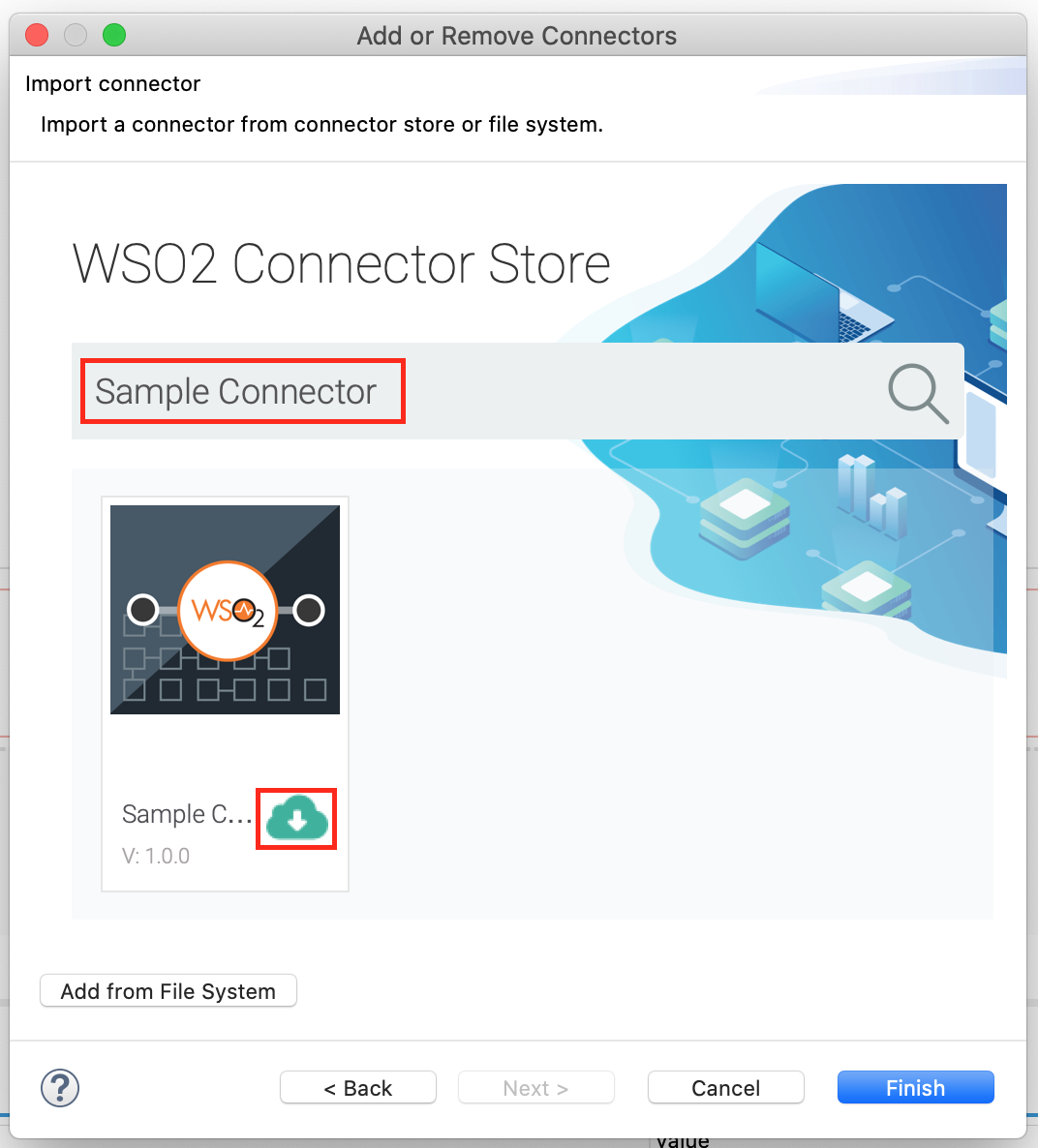
-
Click Finish, and your Integration Project is ready. The downloaded connector is displayed on the side palette with its operations.
-
You can drag and drop the operations to the design canvas and build your integration logic.

-
First let's create postRecord sequence and ReadRecord sequences. Right click on the created Integration Project and select, -> New -> Sequence to create the Sequence.
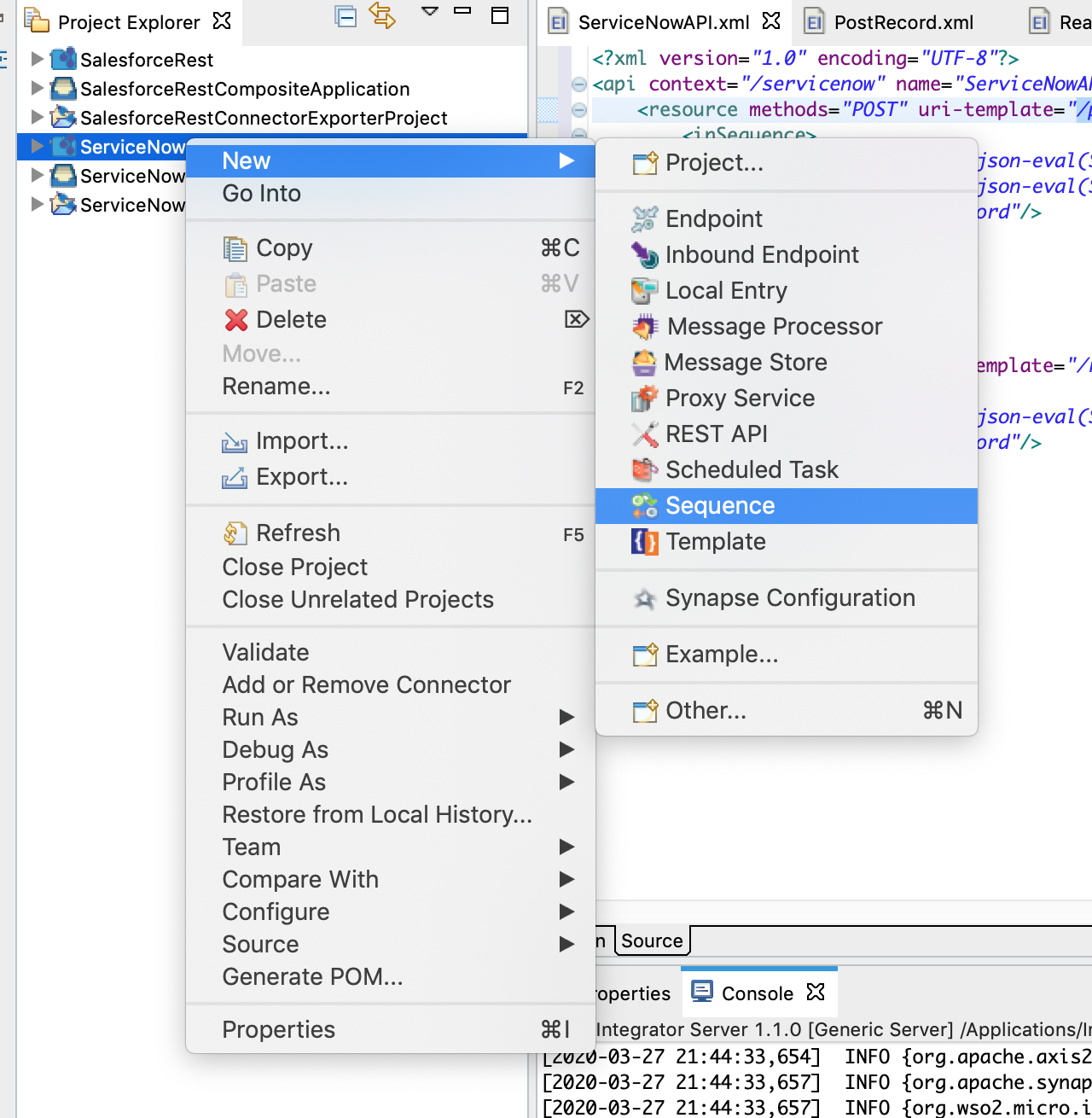
-
Provide the Sequence name as PostRecord. You can go to the source view of the XML configuration file of the API and copy the following configuration.
<?xml version="1.0" encoding="UTF-8"?> <sequence name="PostRecord" trace="disable" xmlns="http://ws.apache.org/ns/synapse"> <servicenow.init> <serviceNowInstanceURL>https://dev55707.service-now.com</serviceNowInstanceURL> <username>admin</username> <password>Diazo123@</password> </servicenow.init> <servicenow.postRecord> <tableName>incident</tableName> <sysparmDisplayValue>true</sysparmDisplayValue> <sysparmFields>short_description,number,sys_id</sysparmFields> <sysparmView>short_description,number,sys_id</sysparmView> <sysparmInputDisplayValue>true</sysparmInputDisplayValue> <number>34</number> <shortDescription>{$ctx:shortDescription}</shortDescription> <active>true</active> <approval>owner</approval> <category>inquiry</category> <contactType>{$ctx:contactType}</contactType> </servicenow.postRecord> <property expression="json-eval($.result.sys_id)" name="sysId" scope="default" type="STRING"/> </sequence> - Create the ReadRecord sequence as below.
<?xml version="1.0" encoding="UTF-8"?> <sequence name="ReadRecord" trace="disable" xmlns="http://ws.apache.org/ns/synapse"> <servicenow.init> <serviceNowInstanceURL>https://dev55707.service-now.com</serviceNowInstanceURL> <username>admin</username> <password>Diazo123@</password> </servicenow.init> <servicenow.getRecordById> <sysId>{$ctx:sysId}</sysId> <tableName>incident</tableName> </servicenow.getRecordById> </sequence> -
Now right click on the created Integration Project and select New -> Rest API to create the REST API.
-
Provide the API name as ServiceNowAPI and the API context as
/servicenow. You can go to the source view of the XML configuration file of the API and copy the following configuration.<?xml version="1.0" encoding="UTF-8"?> <api context="/servicenow" name="ServiceNowAPI" xmlns="http://ws.apache.org/ns/synapse"> <resource methods="POST" uri-template="/postRecord"> <inSequence> <property expression="json-eval($.shortDescription)" name="shortDescription" scope="default" type="STRING"/> <property expression="json-eval($.contactType)" name="contactType" scope="default" type="STRING"/> <sequence key="PostRecord"/> <respond/> </inSequence> <outSequence/> <faultSequence/> </resource> <resource methods="POST" uri-template="/readRecord"> <inSequence> <property expression="json-eval($.sysId)" name="sysId" scope="default" type="STRING"/> <sequence key="ReadRecord"/> <respond/> </inSequence> <outSequence/> <faultSequence/> </resource> </api>
Exporting Integration Logic as a CApp¶
CApp (Carbon Application) is the deployable artifact on the Enterprise Integrator runtime. Let us see how we can export integration logic we developed into a CApp along with the connector.
Creating Connector Exporter Project¶
In order to bundle Connector into a CApp a Connector Exporter Project is needed.
-
Navigate to File -> New -> Other -> WSO2 -> Extensions -> Project Types -> Connector Exporter Project.
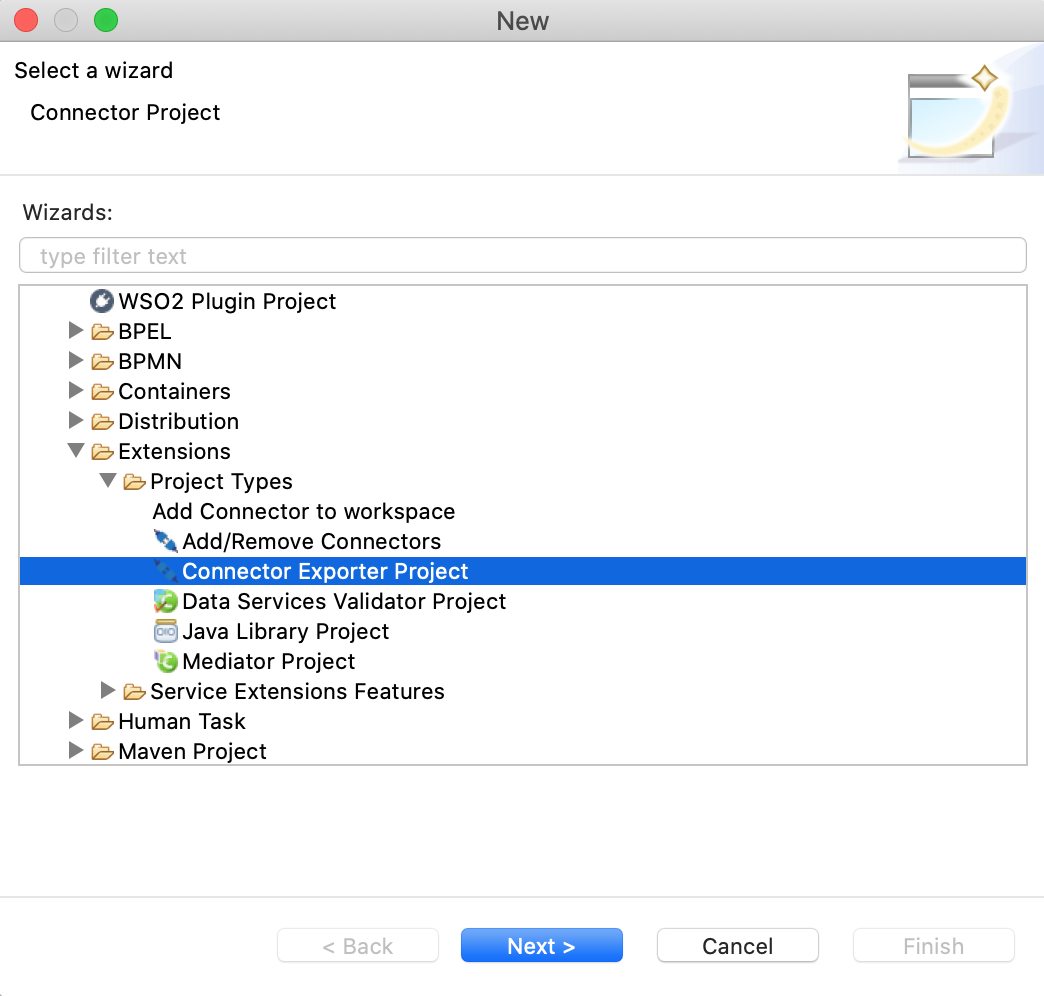
-
Enter a name for the Connector Exporter Project.
-
In the next screen select, Specify the parent from workspace and select the specific Integration Project you created from the dropdown.
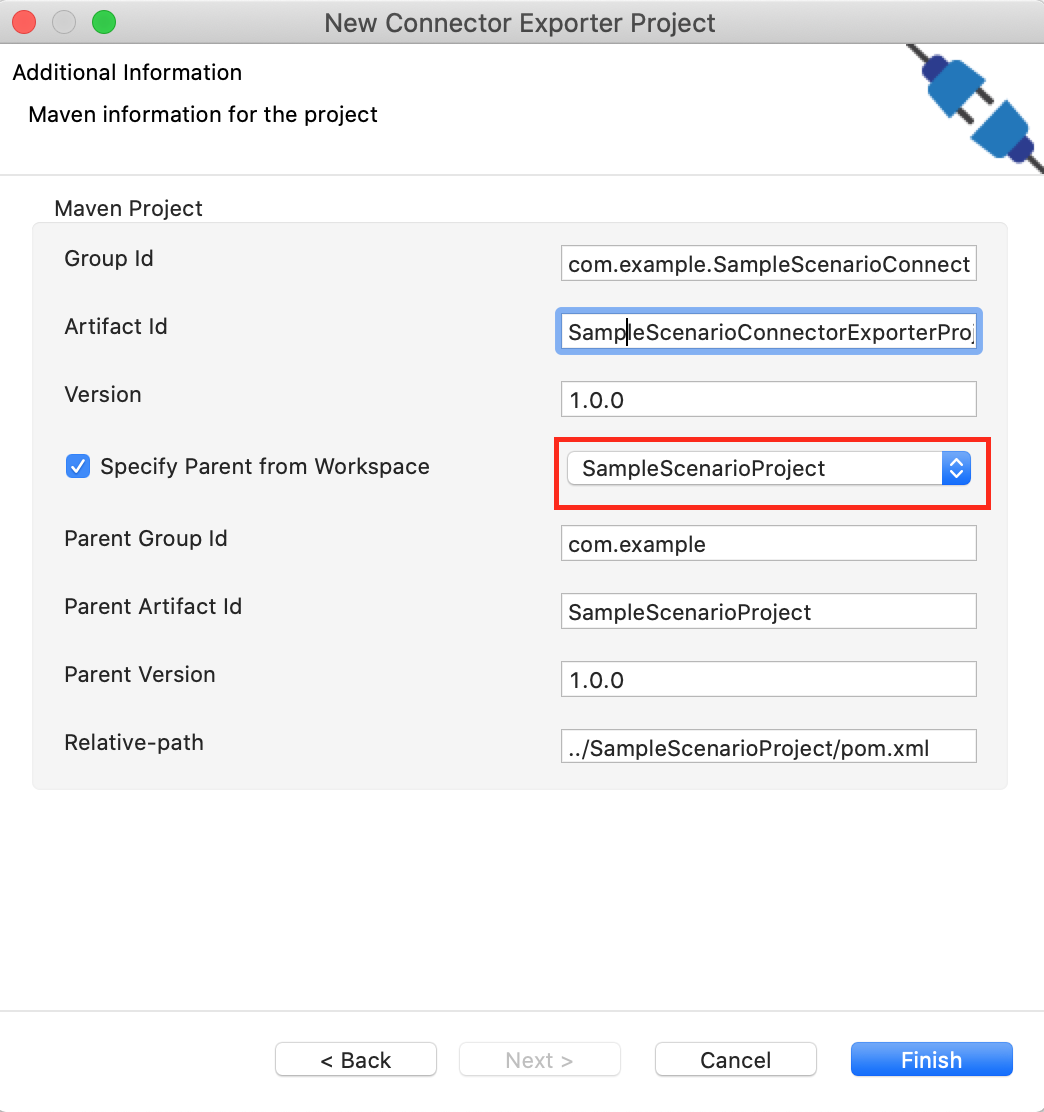
-
Now you need to add the Connector to Connector Exporter Project that you just created. Right click on the Connector Exporter Project and select, New -> Add Remove Connectors -> Add Connector -> Add from Workspace -> Connector
-
Once you are directed to the workspace, it displays all the connectors that exist in the workspace. You can select the relevant connector and click Ok.
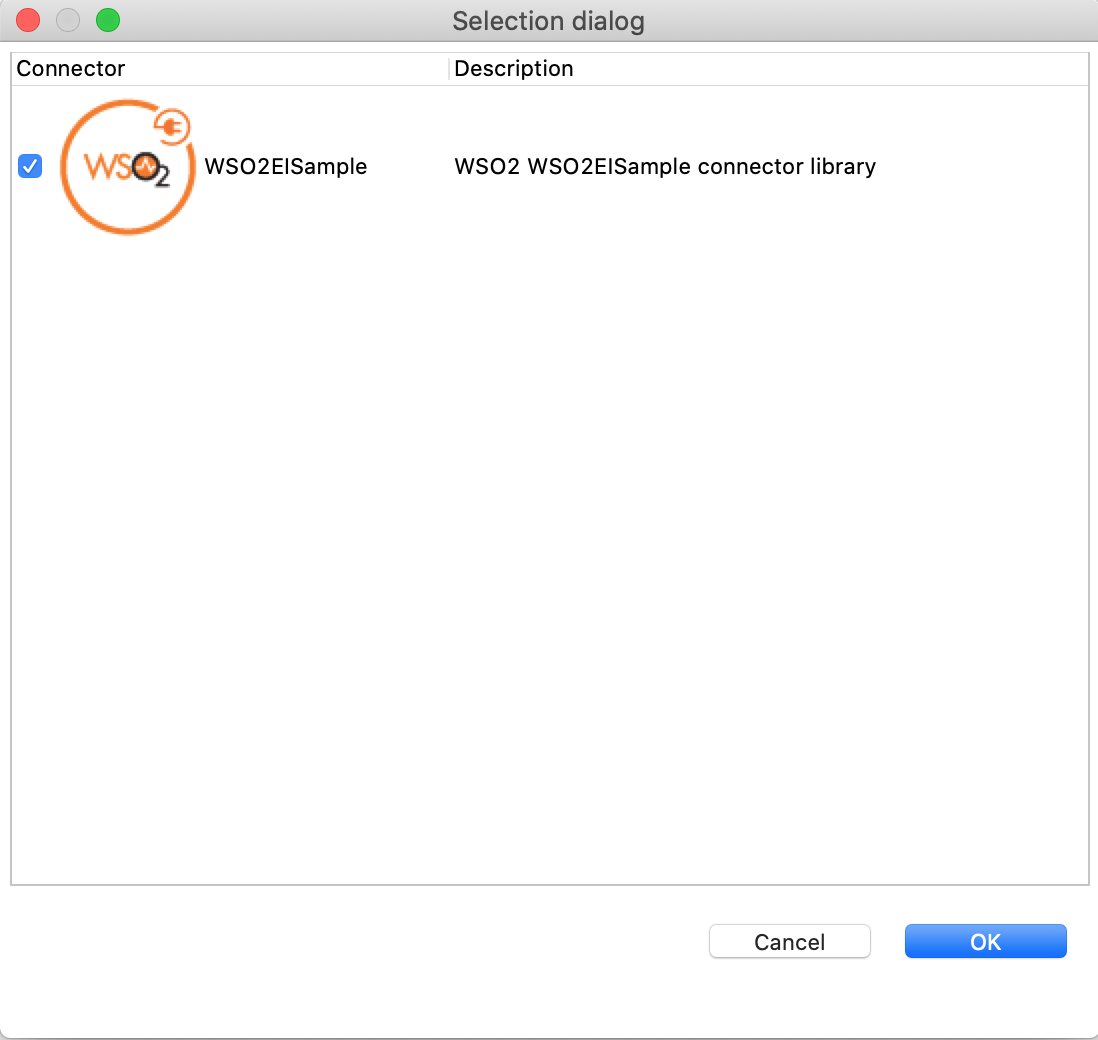
Creating a Composite Application Project¶
To export the Integration Project as a CApp, a Composite Application Project needs to be created. Usually, when an Integration project is created, this project can be created as part of that project by Integration Studio. If not, you can specifically create it by navigating to File -> New -> Other -> WSO2 -> Distribution -> Composite Application Project.
Exporting the Composite Application Project¶
-
Right click on Composite Application Project and click on Export Composite Application Project.
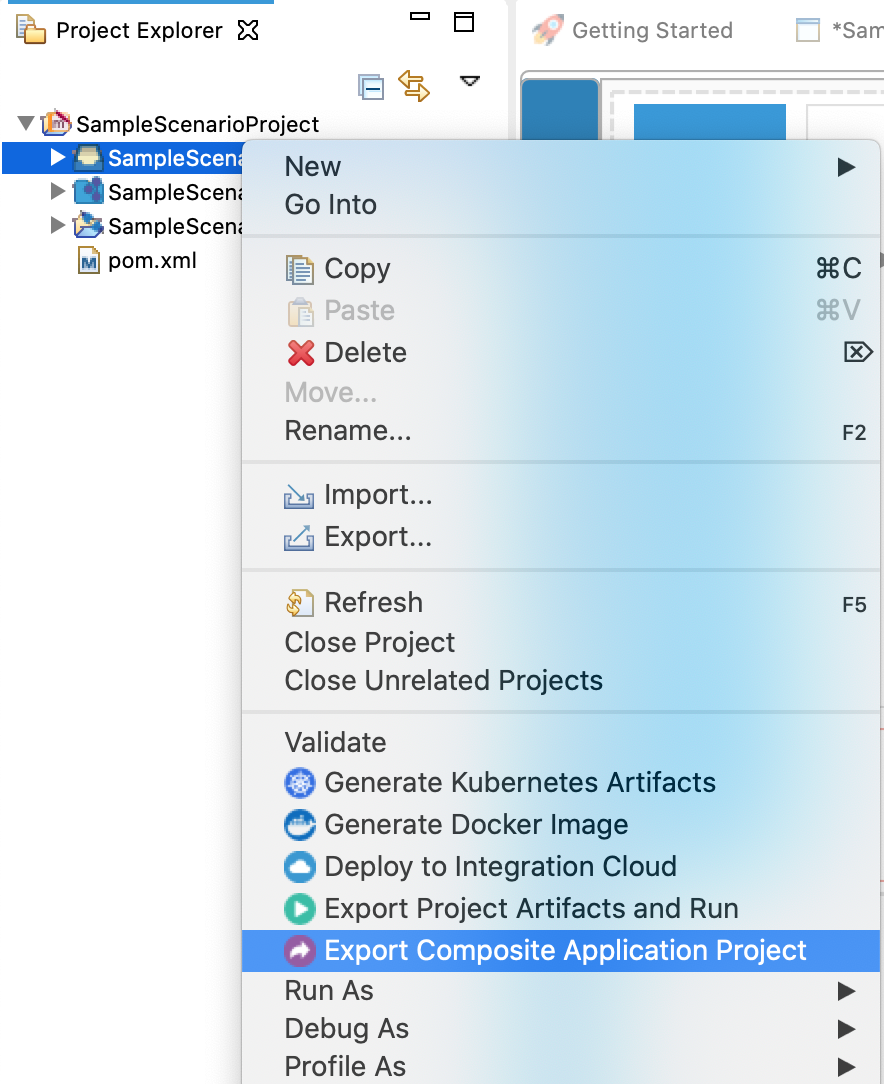
-
Select an Export Destination where you want to save the .car file.
-
In the next Create a deployable CAR file screen, select both the created Integration Project and the Connector Exporter Project to save and click Finish. The CApp will get created at the specified location provided at the previous step.

Get the project¶
You can download the ZIP file and extract the contents to get the project code.
Tip
You may need to update the instance details and make other such changes before deploying and running this project.
Deployment¶
Follow these steps to deploy the exported CApp in the Enterprise Integrator Runtime.
Testing¶
Post Record Operation¶
- Create a file called data.json with the following payload. You can further refer to the parameters from here.
{ "shortDescription":"Incident type: L2", "contacttype":"email" } - Invoke the API as shown below using the curl command. Curl Application can be downloaded from [here] (https://curl.haxx.se/download.html).
Expected Response: You should get the following response with the 'sys_id' and keep it saved.curl -H "Content-Type: application/json" --request POST --data @body.json http://localhost:8290/servicenow/postRecord{ "result": { "short_description": "Incident type: L2", "number": "34", "sys_id": "fd7e0271073f801036baf03c7c1ed0ff" } }
Read Record Operation¶
- Create a file called data.json with the following payload. Make sure you paste above saved sys_id as the sysId below.
{ "sysId":"fd7e0271073f801036baf03c7c1ed0ff" } - Invoke the API as shown below using the curl command. Curl Application can be downloaded from [here] (https://curl.haxx.se/download.html).
curl -H "Content-Type: application/json" --request POST --data @body.json http://localhost:8290/fileconnector/readrecord
Expected Response: You should get the following text returned.
{
"result":{
"parent":"",
"made_sla":"true",
"caused_by":"",
"watch_list":"",
"upon_reject":"cancel",
"sys_updated_on":"2020-03-27 17:45:43",
"child_incidents":"0",
"hold_reason":"",
"approval_history":"",
"number":"34",
"resolved_by":"",
"sys_updated_by":"admin",
"opened_by":{
"link":"https://dev55707.service-now.com/api/now/table/sys_user/6816f79cc0a8016401c5a33be04be441",
"value":"6816f79cc0a8016401c5a33be04be441"
},
"user_input":"",
"sys_created_on":"2020-03-27 17:45:43",
"sys_domain":{
"link":"https://dev55707.service-now.com/api/now/table/sys_user_group/global",
"value":"global"
},
"state":"1",
"sys_created_by":"admin",
"knowledge":"false",
"order":"",
"calendar_stc":"",
"closed_at":"",
"cmdb_ci":"",
"delivery_plan":"",
"contract":"",
"impact":"3",
"active":"true",
"work_notes_list":"",
"business_service":"",
"priority":"5",
"sys_domain_path":"/",
"rfc":"",
"time_worked":"",
"expected_start":"",
"opened_at":"2020-03-27 17:45:43",
"business_duration":"",
"group_list":"",
"work_end":"",
"caller_id":"",
"reopened_time":"",
"resolved_at":"",
"approval_set":"",
"subcategory":"",
"work_notes":"",
"short_description":"Incident type: L2",
"close_code":"",
"correlation_display":"",
"delivery_task":"",
"work_start":"",
"assignment_group":"",
"additional_assignee_list":"",
"business_stc":"",
"description":"",
"calendar_duration":"",
"close_notes":"",
"notify":"1",
"service_offering":"",
"sys_class_name":"incident",
"closed_by":"",
"follow_up":"",
"parent_incident":"",
"sys_id":"fd7e0271073f801036baf03c7c1ed0ff",
"contact_type":"",
"reopened_by":"",
"incident_state":"1",
"urgency":"3",
"problem_id":"",
"company":"",
"reassignment_count":"0",
"activity_due":"",
"assigned_to":"",
"severity":"3",
"comments":"",
"approval":"not requested",
"sla_due":"",
"comments_and_work_notes":"",
"due_date":"",
"sys_mod_count":"0",
"reopen_count":"0",
"sys_tags":"",
"escalation":"0",
"upon_approval":"proceed",
"correlation_id":"",
"location":"",
"category":"inquiry"
}
} What's Next¶
- You can deploy and run your project on Docker or Kubernetes. See the instructions in Running the Micro Integrator on Containers.
- To customize this example for your own scenario, see ServiceNow Connector Configuration documentation for all operation details of the connector.
